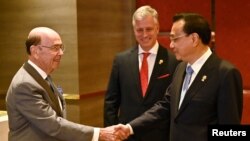The U.S. Secretary of Commerce announced this week that the United States plans to invest and trade more in Asia.
Secretary Wilbur Ross spoke about American efforts to support “sustainable” projects in Asia as a way to answer China’s “Belt and Road” infrastructure program.
Ross and U.S. President Donald Trump’s national security adviser, Robert O’Brien, were in Thailand for a meeting of the Association of Southeast Asian Nations, or ASEAN.
Like O’Brien, Ross tried to overcome suspicions that the Trump administration is uninterested in Asia. The president sent his adviser to the ASEAN summit, but he himself did not attend for the second time in two years.
“We have no intention of vacating our military or geopolitical position,” Ross told reporters. He added that many people had misunderstood Trump’s 2017 decision to pull out of the Trans-Pacific Partnership trade deal.
“We are here permanently, and we will be continuing to invest more here, and we will be continuing to have more bilateral trade,” Ross said.
To demonstrate that desire, U.S. officials launched the Trump administration’s “Blue Dot Network” on Monday at a conference of business leaders. More than 200 American business leaders attended the meeting.
The plan’s name comes from a picture of Earth taken by the Voyager 1 spacecraft. The name is also the name of a book written by American scientist Carl Sagan.
Ross said the Blue Dot Network will include countries that want “sustainable infrastructure development.” Earlier, O’Brien compared the network to a “Michelin Guide” for rating investment projects in infrastructure, such as roads, ports and energy systems.
It is unclear what kind of investments would come from the Blue Dot Network plan. The U.S. government described it as an alliance of governments, companies and civil society that would operate under “shared standards.”
During the meetings in Bangkok, Japan and the United States signed an agreement to work together on $10 billion in Japanese investment in liquefied natural gas projects. Other plans include an agreement to work with the Asian Development Bank in getting up to $7 billion in financing for other Asian energy projects.
O’Brien said the plan would help countries avoid paying for projects that forced them to take on too much debt and were not “high quality.” O’Brien was speaking about China’s “Belt and Road” infrastructure projects. U.S. officials have said the Chinese-supported projects hurt the financial systems of the countries involved by tying them to large debts.
Ross talked about U.S. trade and investment in East Asia and the Pacific, saying of Australia, “We’d be (happy) to sell more military aircraft if that suits your department of defense.”
On Tuesday, China opened a large conference on imports in Shanghai to demonstrate its desire to do business.
President Xi Jinping promised to open Chinese markets even more. He drank wine with French President Emmanuel Macron, who urged Chinese and U.S. officials to end their trade war.
Xi said that China was willing to increase talks on several free trade deals and investment agreements. He also said China was “happy” to enter into high-standard free trade agreements with more countries.” And, he promised to improve conditions for foreign investment.
I’m Dorothy Gundy.
The Associated Press reported this story. Susan Shand adapted it for VOA Learning English. George Grow was the editor.
Write to us in the Comments Section or on our Facebook page.
_______________________________________________________________
Words in This Story
sustainable – adj. involving methods that do not completely use up or destroy natural resources
infrastructure – n. the equipment and structures (such as roads and bridges) that are needed for a place to operate effectively
summit – n. a meeting or series of meetings between the leaders of two or more governments
vacate – v. to leave
bilateral – adj. between two sides
network – n. an interconnected group or alliance of persons or businesses
standard – n. a level of quality that is considered acceptable or desirable
suit – v. to be proper or suitable for (someone or something)







